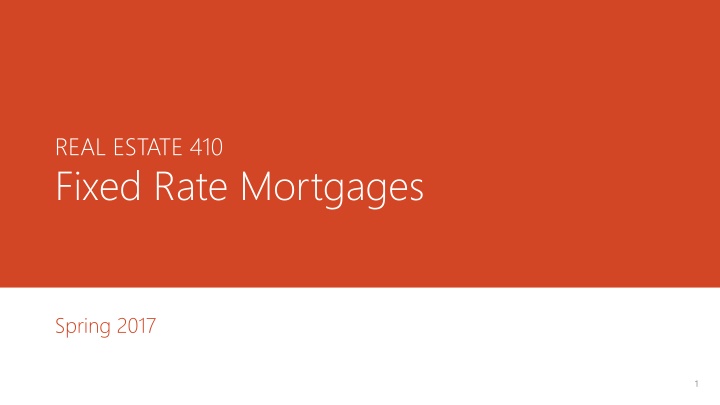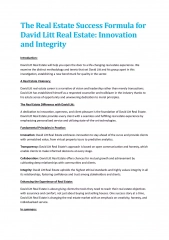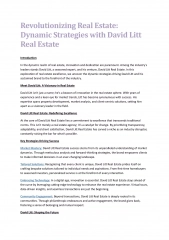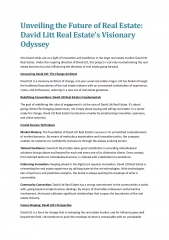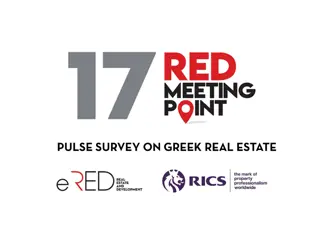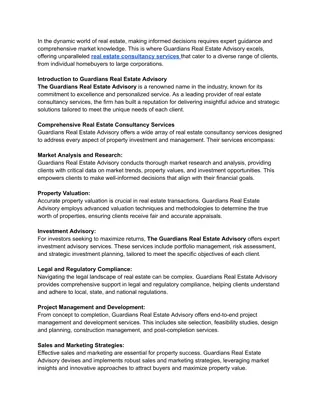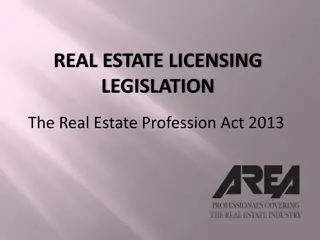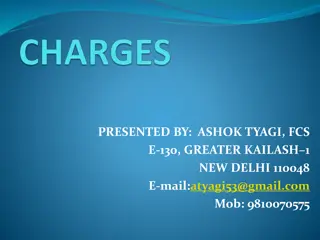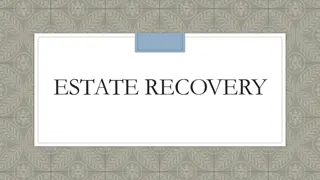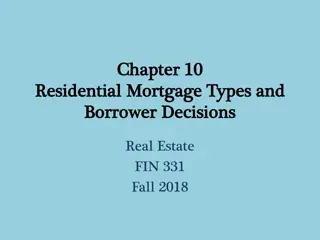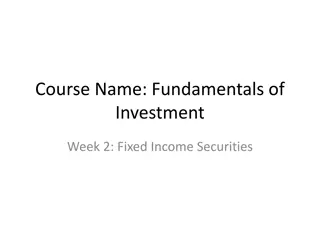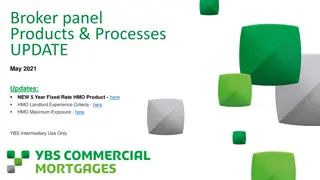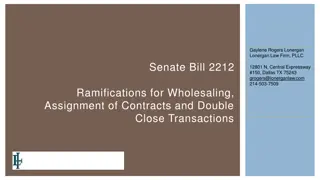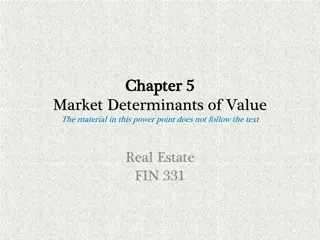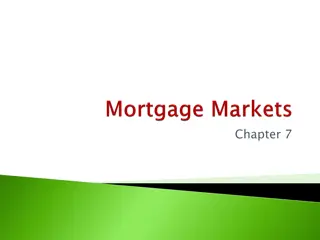Fixed-Rate Mortgages in Real Estate
Fixed-rate mortgages (FRMs) offer stability with a consistent interest rate throughout the loan term. Explore topics like constant payment mortgages (CPM), financing costs, and effective borrowing. Learn about the benefits of CPM, amortization, and how to calculate periodic payments. Dive into examples and understand mortgage constants to make informed decisions in real estate financing.
Download Presentation

Please find below an Image/Link to download the presentation.
The content on the website is provided AS IS for your information and personal use only. It may not be sold, licensed, or shared on other websites without obtaining consent from the author.If you encounter any issues during the download, it is possible that the publisher has removed the file from their server.
You are allowed to download the files provided on this website for personal or commercial use, subject to the condition that they are used lawfully. All files are the property of their respective owners.
The content on the website is provided AS IS for your information and personal use only. It may not be sold, licensed, or shared on other websites without obtaining consent from the author.
E N D
Presentation Transcript
REAL ESTATE 410 Fixed Rate Mortgages Spring 2017 1
Topics Constant payment mortgages Financing cost and yield calculations Effective borrowing cost Reverse Mortgages Other mortgage products 2
Fixed-Rate Mortgages Technically, a fixed rate mortgage (FRM) is any mortgage with a fixed interest rate over the life of the loan. FRM loan terms: Loan amount Limits for conforming conventional home mortgages Loan maturity date of 15 to 30 years Fixed interest rate Periodic payments The amount of payments will depend on payment terms, interest rate, and loan maturity date Payments can technically be fixed or variable 3
Constant Payment Mortgage Constant payment mortgage (CPM) is commonly referred to as FRM Most common form of financing for residential in the U.S. CPM has the following three characteristics: 1. Fixed interest rate 2. Leveled payments Fixed periodic payments (usually in arrears, i.e., at period s end) Payments are usually monthly for most home mortgages 3. Fully amortizing Periodic payments consist of both interest and amortization of principal, which is fully repaid at the end of the term. Equity buildup over time (Is this a real benefit?) Residential CPMs are usually for 15, 20, or 30 years. 4
CPM DS Calculation Example 1 Consider a CPM loan of $500,000 at 12% for 25 years, compounded annually. What is the periodic DS in order to fully repay the loan after 25 payments? At origination, the PV of payments equal to loan amount. DS + DS + DS = + + 500 $ 000 , + 2 25 (1 12%) (1 12%) (1 12%) This is the special case of the more general formula seen earlier. NB: The periodic discount rate is the annual interest rate divided by the number of payment during the year. Since payment are annual in this example, the discount rate is equal to the interest rate. 5
CPM DS Calculation DS + DS + DS = + + 500 $ 000 , + 2 25 (1 12%) (1 12%) (1 12%) Therefore, we have: 1 = 500 $ 000 , DS 1 1 1 + + + + + 2 25 (1 12%) (1 12%) (1 12%) 6
CPM DS Calculation 1 = DS $500,000 Mortgage Constant PVAIF 12%,25 1 1 1 = + + PVAIF 12%,25 + (1 12%) + (1 12%) + 2 25 (1 12%) 7.84314 = PVAIF 12%,25 PVAIF12%, 25 is the PV of an annuity factor at 12% for 25 years. It is the PV of a stream of $1 CFs. The inverse of PVAIF12%, 25 is referred to as the mortgage constant. 7
CPM DS Calculation If you want, you can first calculate the mortgage constant as presented here and then multiply with loan amount to get the periodic payment as done below. 1 = DS $500,000 PVAIF 12%,25 = = DS $500,000 0.12750 $63,749.98 But it is much easier these days to a financial calculator or Excel: Calculator: PV=500,000; FV=0; I=12%; N=25; PMT=? Excel: PMT(rate (12%), nper (25), PV(500,000), FV(0)) 8
Example 2 Calculating the Payment for a CPM $100,00 Mortgage 7% Interest rate 30 Years Monthly Payments Solution: PV = $100,000 n = 30 x 12 = 360 FV = $0 i = 7/12 = .5833 (or change P/Y to 12 and enter 7) PMT = $665.30 9
Example 2 Interest paid in the first month (.07/12) x $100,000 = $583.33 Principal paid in the first month $665.30 - $583.33 = $81.96 Every month, interest portion declines and the principal portion increases. Why? Because you are paying down the mortgage! 10
Amortization Schedule Period Loan Balance Payment Accrued Interest Principal Repayment Ending Balance 1 2 3 4 5 $100,000.00 $99,918.03 $99,835.58 $99,752.66 $99,669.24 $665.30 $665.30 $665.30 $665.30 $665.30 $583.33 $582.86 $582.37 $581.89 $581.40 $81.97 $82.45 $82.93 $83.41 $83.90 $99,918.03 $99,835.58 $99,752.66 $99,669.24 $99,585.34 356 $3,269.08 $665.30 $19.07 $646.23 $2,622.85 357 $2,622.85 $665.30 $15.30 $650.00 $1,972.85 358 $1,972.85 $665.30 $11.51 $653.79 $1,319.05 359 $1,319.05 $665.30 $7.69 $657.61 $661.44 360 $661.44 $665.30 $3.86 $661.44 $0.00 11
Amortization Schedule $700.00 $600.00 $500.00 $400.00 $300.00 $200.00 $100.00 $0.00 109 121 133 145 157 169 181 193 205 217 229 241 253 265 277 289 301 313 325 337 349 13 25 37 49 61 73 85 97 1 Payment Accrued Interest Principal Repayment 12
Example 3 CPM with these characteristics $60,000 Mortgage 12% Interest rate 30 Years Monthly Payments? Solution PV = $60,000 n = 30 x 12 = 360 FV = $0 i = 12/12 = 1 (or change P/Y to 12 and enter 12) PMT = $617.17 13
Example 3 Monthly Payment, Principal, Interest, and Loan Balances 14
Example 3 - Extension Relationship between Monthly Mortgage Payments and Maturity Periods 15
Computing Loan Balance This is essentially about removing the interest that was built into the periodic payments due. Methods: Amortization schedule Long and cumbersome Mathematical methods 1. Compute the present value of the remaining payments using the fundamental equation (PV Method). 2. Start from an earlier period balance and compute the future value of the previous CFs (FV Method) 16
PV Method The outstanding loan balance (OLB) at time t is the PV at time t of remaining periodic payments discounted at the contracted interest rate. For Example 2, what is the remaining balance at the end of year 8 (OLB96)? PMT = $665.30 n = 22 x 12 = 264 FV = $0 i = 7/12 = .58333 OLB96 = PV = $89,491.65 17
FV Method The outstanding loan balance (OLB) at time t is also the FV at time t of the initial loan amount (or any previous loan balance) and periodic payments in between compounded at the contracted interest rate. (NB: Watch out cash flow signs!) Example 2 (again) OLB96 =? PMT = $665.30 n = 8 x 12 = 96 PV = -$100,000 i = 7/12 = .58333 OLB96 = FV = $89,491.65 18
Loan Costs Additional finance charges levied by the lender that are part of the cost of borrowing: Origination Fees Cover origination expenses. Discount Fees (Points) Borrower trade-off: points vs. contract rate 1 Point = 1% of the loan amount Used to raise the yield on the loan Prepayment Penalty Fees charged by the lender on the outstanding loan balance at the time of prepayment (not allowed for some residential mortgages) By adjusting the fees that are charged, different effective returns or yields may be achieved by mortgage lenders. 19
Effective Borrowing Cost (Yield) The borrower s effective borrowing cost is the lender s effective yield! The effective borrowing cost is the discount rate that makes the present value of periodic loan payments equal to the net loan proceeds received by the borrower, i.e. loan amount minus commissions and fees. ? ??? ???? ???????? = (1 +??? ?)? ?=1 20
Origination Fees Origination or financing fees are generally meant to compensate the lender for origination costs, which are normally different from true borrowing costs. Since origination costs are higher for commercial mortgages, origination fees are more common there. The possibility of prepayment make most lenders reluctant to include these costs in the interest rate charged on the loan. Why? These fees result in: Effective yield being higher than the contract rate Effective yield decreases with time to prepayment 21
Origination Fees Example 3 (again) A $60,000 mortgage at 12% interest rate for 30 years with monthly payments of $617.17 Assume the lender charges a 3% origination fees. What is the effective yield if the mortgage is held to maturity? Loan proceeds = 60,000*(1-.03) = $58,200 PV = $58,200 FV = $0 n = 360 PMT = - $617.17 i = 12.41% 22
Origination Fees Same question, but the mortgage is now repaid at the end of year 5. Outstanding Loan Balance at end of yr. 5? PMT = $617.17 n = 25*12 = 300 i =12% FV = $0 Effective Yield? PV = $58,200 FV = ($58,597.93) n = 60 PMT = ($617.17) If the mortgage is repaid after 1 year, the effective yield would be 15.26% (do the math). OLB60 = $58,597.93 i = 12.82% 23
Origination Fees Impact of origination fees on effective yield at various repayment dates for Example 3. 24
Discount Points Discount points (or points) are fees generally charged by lenders in lieu of higher interest rates. They are similar to, but somewhat different, from origination fees because a borrower may opt to pay points in order to bring down the interest rate? Lenders may charge points for various reasons: Point are a way to price in the risk of a borrower. Point may also be used to mitigate prepayment risk. With mortgage rates being sticky, lenders may use points to increase returns. They could be used to cover origination and overhead costs, but origination fees would probably fit better. They could allow lenders to earn a profit on loans sold to investors at a yield equal to or lower than the loan interest rate. 25
Discount Points Example 4 1. What is the effective borrowing cost for this loan? Home value: $250,000 80% LTV Loan at 8% Interest with 4 points 30 years with monthly payments Solution: Step 1: Compute periodic payment PV = 250,000*.80 = $200,000 n = 360 i = 8%/12 PMT = $1,467.53 As with origination fees, the borrower actually receives less than the full loan amount. 26
Discount Points Example 4 Step 2: Loan Amount Points Paid =.04 x $200,000 Amount Received Compute the effective borrowing cost, using the amount received from Step 2 and the payment from Step 1. PV = $192,000 n = 360 PMT = $1467.53 i = .70*12 = 8.44% As expected, the effective borrowing is slightly higher! $200,000 $8,000 $192,000 27
Discount Points Example 4 2. What is the effective cost if the loan might be repaid after 8 years? Step 1: Compute PMT = $1467.53 Step 2: Compute the outstanding balance at end of year 8 FV = $0 n = 24*12 = 264 PMT = $1467.53 i = 8/12 OLB96 = PV = $182,035.40 28
Discount Points Example 4 Step 3: Compute effective interest cost. PV = $192,000 FV = ($182,035.40) PMT = ($1467.53) n = 96 i = 0.73*12 = 8.72% Therefore, points increase the effective cost of financing, particularly for borrowers who prepay. As result, pointsare a valuable tool for assessing prepayment risk since, unlike with origination fees, borrowers often can choose a higher rate instead! 29
Prepayment Penalties Prepayment penalties are meant to discourage prepayments. They are generally 1-3% of the loan balance They are added to the final payment when computing yields Prepayment risk is an important consideration to lenders because, on average, prepayments negatively affect yields. Prepayment penalties allow lenders to optimally price prepayment risk rather than spread the costs to all. Conforming conventional mortgages allow repayments without penalties. Prepayment penalties for common for non-conforming mortgages and commercial mortgages 30
Prepayment Penalties Suppose now that the loan in Example 4 comes with a prepayment penalty of 2%. What is the effective yield if the loan prepays at the end of year 8? Solution: OLB96 = $182,035.40 Net payment at the end year 5 = $182,035.40*1.02 Effective interest rate = ? PV = $192,000 ($200K minus 4% discount points) FV = ($185,676.11) PMT = ($1467.53) n = 96 i = 0.74%*12 = 8.89% 31
Annual Percentage Rate The Annual Percentage Rate (APR) is the discount rate which brings the future payment stream back to present value such that it exactly equals the net cash disbursed by the lender. To prevent residential mortgage lenders from advertising low rates and hiding fees, True in Lending Act requires that lenders disclose APR to borrowers . APR still confusing because it assumes that the loan is held to maturity and it does not include all fees (e.g., prepayment penalties). Calculation is similar to effective interest rate calculations. 32
Effective Borrowing Cost Lenders offer borrowers a choice between different combinations of discount points and interest rates. E.g., high interest rate with a low to no discount points or low interest rate with high discount points. The challenge for the borrower is choosing the mortgage contract that minimizes the real cost of borrowing. Effective borrowing cost expresses interest rate and all fees on the mortgage loan as a single annualized rate. It is the IRR that equalizes the disbursed loan amount (loan less any fees or commissions) to the PV of all periodic payments. It is similar to the effective yield on a loan computed by the lender. 33
Effective Borrowing Cost Differences between Effective Borrowing Cost and APR APR assumes that loan is held to maturity, whereas effective borrowing cost uses expected investment holding period. APR and effective borrowing cost are the same if mortgage held to maturity and all costs are included in APR. Otherwise, effective borrowing cost is higher. For adjustable rate mortgages, APR calculations are based on initial interest rate, and may therefore be misleading. Mortgages should be compared using effective borrowing cost rather than APR. 34
Effective Borrowing Cost Example A borrower has a choice between two $500,000, 30-year mortgages. Mortgage 1: A 10% contract rate (compounded monthly) plus a 4% origination fee. Mortgage 2: A contract rate of 11% (compounded monthly) with no origination fee. Which one of these two mortgages is cheaper if the loan is held to maturity? 35
Effective Borrowing Cost Solution: We need to compute the effective borrowing cost for each mortgage and choose the one with the lowest IRR in this case the effective borrowing cost is the APR. Mortgage 1 DS1=? PV=$500K, FV=0, i=10%/12, N=360. Thus PMT1=$4,387.86 IRR1=? Loan Proceeds = (1-0.04)*500,000=$480,000 N=360; PMT=$4,387.86, FV=0, PV =$480,000 Solving this gives: IRR1=0.87433%*12=10.49% 36
Effective Borrowing Cost Mortgage 2 Since no point is charged for the this mortgage, the effective borrowing cost and contract rate are the same: IRR2=11% Therefore, Mortgage 1 is cheaper than Mortgage 2 because it has a lower effective borrowing cost. But be careful! The above calculation spreads the origination fee for Mortgage 1 over the 30-year term in fact the IRR is the APR here. IRR would be higher if borrower prepays as we saw earlier. Mortgage 2 might even be preferable. 37
Effective Borrowing Cost Example The table below compares two loans of $240,000 where the APR is not the best indicator of the best consumer choice if the loan is to be held 5 years or less The quicker the loan is to be repaid the better choice A becomes even though the initial contract rate is higher 38
Partially Amortizing FRM Only a portion of the loan is amortized and repaid during the life of the loan. Periodic payments cover interest accrued and loan amortization, which is smaller compared to full amortization. Borrower builds up equity over time, but less than for fully amortizing CPMs. At the maturity of the loan, the borrower needs to repay the unamortized portion of the loan (called the balloon payment hence these loans are referred as balloon mortgages). 39
Partially Amortizing FRM Smaller equity buildup than under fully amortizing CPM. Is it a problem for the borrower? Riskier for the lender than a (fully amortizing) CPM. Why? Smaller amortizations, therefore higher LTV than CPM over time Balloon payment involves refinancing risk because loans are often refinanced at maturity. Very common in commercial real estate finance. 40
Partially Amortizing FRM Example 2 (again) Assume $100,000 partially amortizing mortgage with a $30,000 balloon for 30 years at 7% with monthly payments. Solution: PV = $100,000 n = 30 x 12 = 360 FV = - $30,000 i = 7% per year PMT = - $640.71 Except for the 1st payment, the interest piece will be higher than for fully amortizing CPM. 41
Interest-Only FRM For interest-only (IO) mortgages, there is no amortization of the loan principal. Periodic payments cover only accrued interest for the respective period. At the maturity of the loan, the borrower needs to repay the loan principal all at once. Riskier than amortizing mortgages for the lender. No equity buildup Lender somewhat betting on the value of the real estate Substantial refinancing risk at maturity. What risk mitigants can lenders use? IO loans more common in commercial real estate finance. 42
Interest-Only FRM Example 2 (again) Assume $100,000 interest only mortgage for 30 years at 7% with monthly payments. Solution: PV = $100,000 n = 30 x 12 = 360 FV = - $100,000 i = 7% per year PMT = -$583.33 In fact, the calculation is much simpler, PMT is initial loan amount times periodic interest rate PMT = $100,000*0.07/12 = $583.33 43
Negative Amortization Mortgages Periodic payments required during the life of the loan not sufficient to cover interest due. Pay rate smaller than accrual rate. Unpaid interest and is added to the principal each period. No equity buildup, rather equity erosion over time. Traditionally, used in commercial mortgage lending. But became more popular in subprime financing during the recent housing boom negative amortization only allowed for the 1st few years. Negative amortization mortgages risk profile lies between IO and zero- coupon mortgages (discussed next). 44
Negative Amortization Mortgages Example 2 (again) Assume $100,000 mortgage for 30 years with monthly payments and an accrual annual interest rate of 7%, with a negative amortization during the 1st 3 years at 5%. Solution: During the 1st 3 years, the borrower will only pay interest at 5%, the remaining accrued interest will then be added to the loan balance every month, resulting in the loan balance increasing during that period. At the end of the negative amortization period (year 3), the new loan balance will then be fully amortized over the remaining life of the loan (27 years in this case). You have to use Excel or do the calculations manually period by period during the negative amortization period. 45
Negative Amortization Mortgages Solution: (cont.) The loan balance at the end of 3 years is $106,178.35 (refer to the Excel Spreadsheet) Now we need to amortize this amount over 27 years at 7% PV = $ 106,178.35 n = 27 x 12 = 324 FV = 0 i = 7% per year PMT = -$730.31 Because of the negative amortization, payments increase from $665.3 to $730.3. This is a 9.8% increase will be a huge payment shock for the borrower! 46
Zero-Coupon Mortgages As zero-coupon bonds, no periodic payments required during the life of the loan no interest, no principal amortization. Extreme form of negative amortization Interest accrues over the life of the loan and is added to the principal. The loan amount is therefore the PV of the final payment discounted at the accrual interest rate No equity buildup of course, erosion of equity instead. Riskiest of all. Usually allowed for a short term with the balance amortized or refinanced using another loan. More common in commercial real estate financing. 47
Zero-Coupon Mortgages Example 2 (again) Calculating loan balance at maturity if no interest payments or principal amortizations same loan parameters as before. Solution: PV = $100,000 n = 360 i = 7% per annum PMT = 0 FV = - $811,649.75 The amount owed increases exponentially over time. It is unsustainable for long periods, but useful sometimes 48
Loan Balance under Various Structures $300,000.00 $250,000.00 $200,000.00 $150,000.00 $100,000.00 $50,000.00 FA CPM OLB PA CPM OLB IO CPM OLB ZA CPM OLB NA CPM OLB $0.00 100 109 118 127 136 145 154 163 172 181 190 199 208 217 226 235 244 253 262 271 280 289 298 307 316 325 334 343 352 1 10 19 28 37 46 55 64 73 82 91 49
Loan Balance under Various Structures $120,000.00 $100,000.00 $80,000.00 $60,000.00 $40,000.00 $20,000.00 FA CPM OLB PA CPM OLB IO CPM OLB NA CPM OLB $0.00 1 9 105 113 121 129 137 145 153 161 169 177 185 193 201 209 217 225 233 241 249 257 265 273 281 289 297 305 313 321 329 337 345 353 17 25 33 41 49 57 65 73 81 89 97 50
